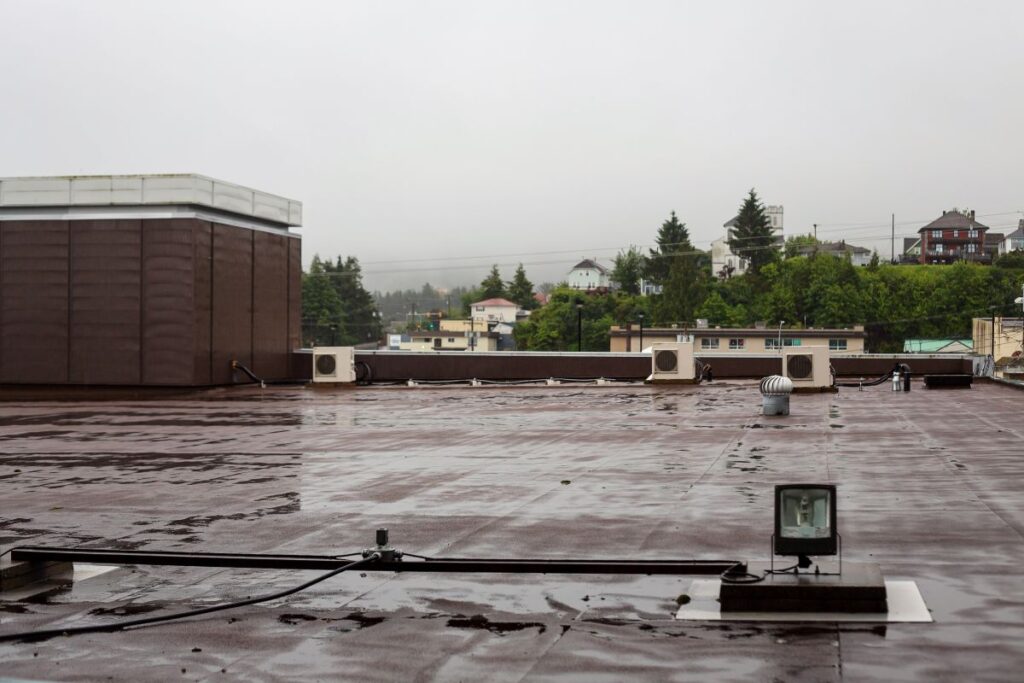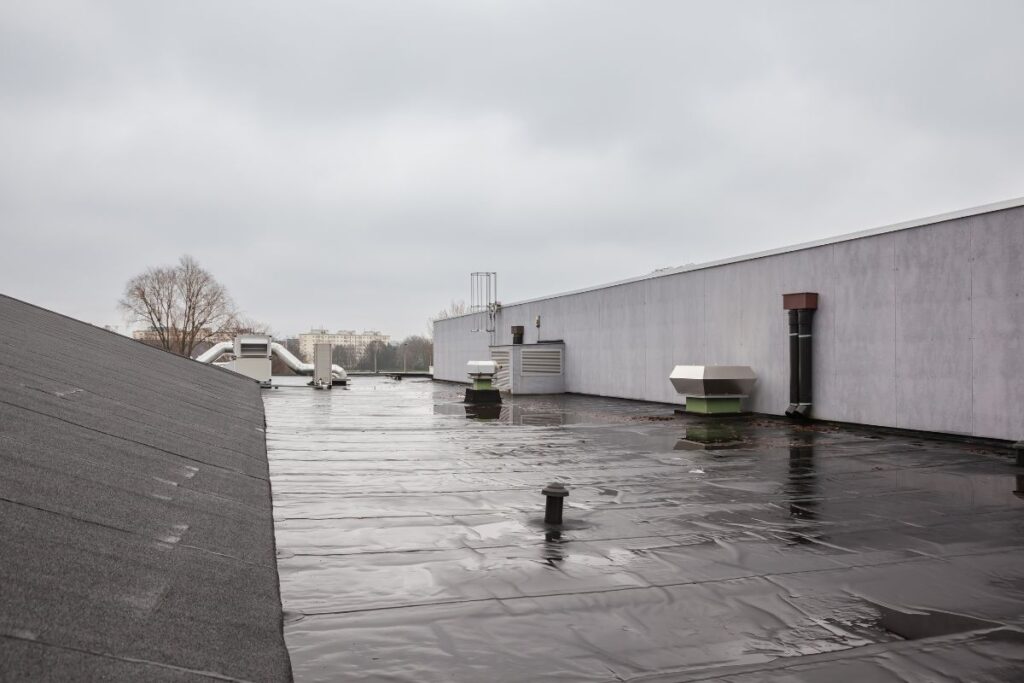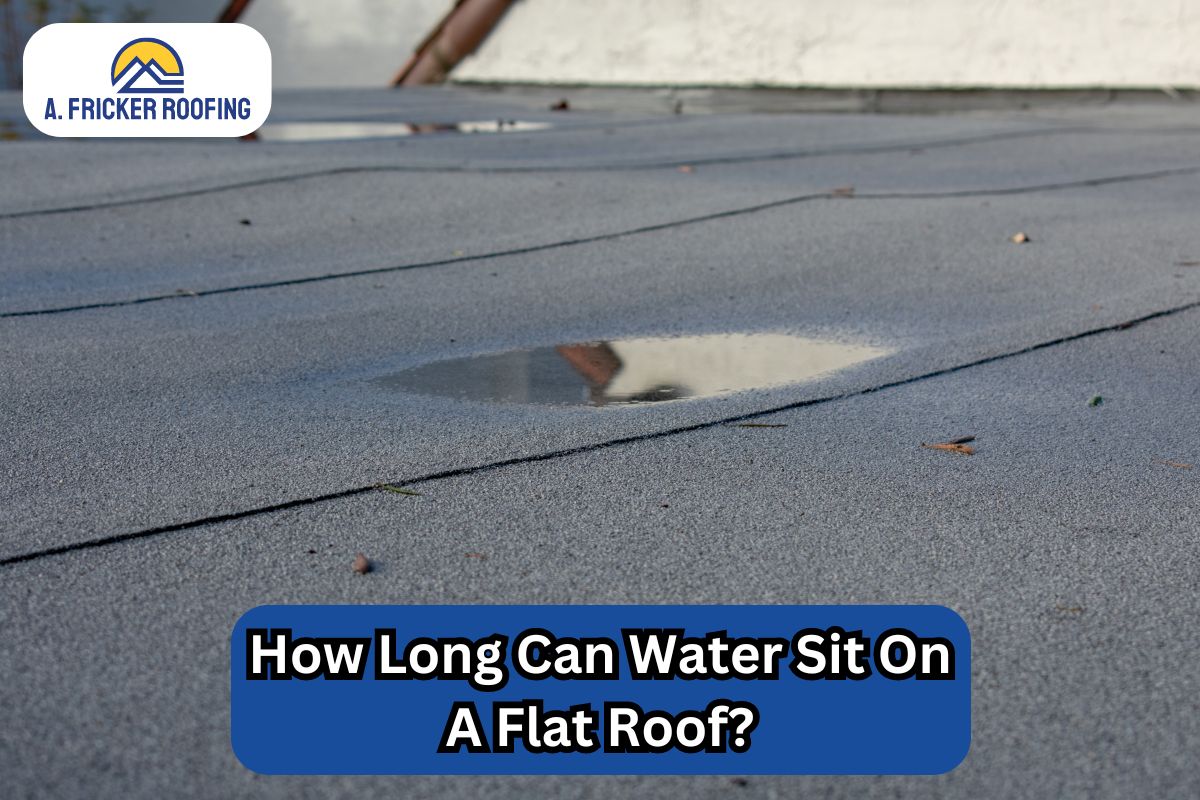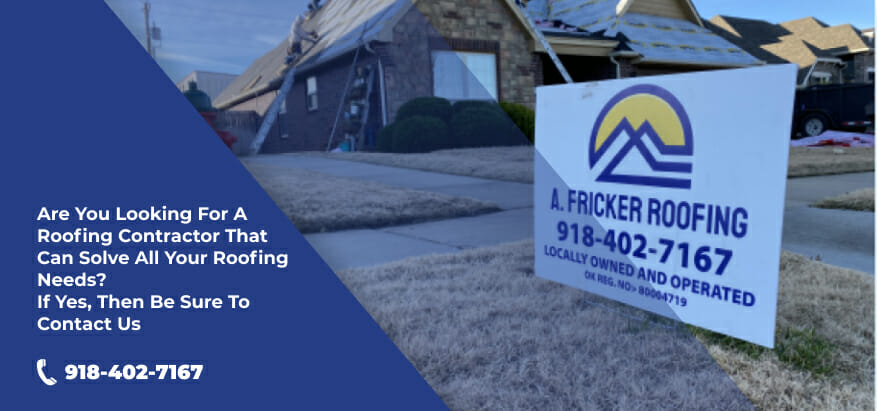A flat roof is the most common roof design used for commercial buildings. Even homeowners have begun choosing flat roofs for a more modern appearance.
If you have a flat roof on your home or business, you might have noticed water lingering there after heavy rainfall. Unlike sloped roofs, which allow water to naturally run off, flat roofs are more likely to experience pooling, which is a phenomenon where water sits on the roof’s surface for long periods of time. For many homeowners, this raises the question of how long can water sit on a flat roof before it becomes a problem.
In this blog post, we’ll cover why water tends to last so long on flat roofs and the risks of letting it sit there unchecked
What Is Ponding Water?

If you have been living in Oklahoma for a while, then you know that the state is no stranger to regular rain. There are times when it can rain for hours, and during these times, water begins to accumulate on the roof, especially when it’s flat.
When puddles form on the surface of the roof and last for more than 24 hours, it’s known as ponding or pooling of water.
But Why Does Water Pool On Your Roof?
If you are considering a flat roof for your home or business, then you should know that flat roofs aren’t entirely flat.
Flat roofs have a slight slope (usually about 1/4 inch per foot) designed to help water drain. However, this slope isn’t as effective as a typical pitched roof, so water naturally tends to stay on the roof’s surface for a while after heavy rain.
Now, small amounts of water staying on the roof for a day or two is perfectly normal. But, when water doesn’t seem to drain away at all, or pooling develops in certain areas after the rain has stopped, you could have an issue.
Here are some of the things that could keep water sitting on the surface of your roof:
Clogged drains and gutters: Flat roofs depend heavily on drainage systems to move water away from their surface. If your drains or gutters are clogged with leaves, dirt, or other debris, water has nowhere to go and floods back onto the roof.
Dips or low spots on roofs: Over time, sections of the roof may sag or develop low spots due to age, weather damage, or poor installation. These areas tend to collect water because they’re lower than the rest of the roof.
Installation Issues: In some cases, flat roofs aren’t built with the right slope, or they don’t have the right drainage features. This could lead to chronic pooling.
So, it’s easy to see why water may sit on a flat roof for a while. But at what point should you start worrying?
How Long Is Too Long?
Water can stay on your roof for different periods of time. But here’s the good news: not every puddle is a crisis. If you notice a case of standing water for 24 to 48 hours after heavy rain, it’s usually nothing to stress over. Flat roofs are designed to handle a little bit of standing water, especially right after rainfall.
However, if the water hasn’t drained or evaporated after 48 hours, that’s when you should start paying attention. Why? Because long-term pooling can cause significant damage over time.
What Are the Risks of Prolonged Water Pooling?

So, what’s the harm in letting water sit on your roof for longer than two days? Well, there’s a variety of risks that come with it, and they’re not something you want to ignore.
Roof Deterioration:
Water is a roof’s worst enemy, and flat roofs are especially vulnerable to water damage. When water pools, it can break down the materials that make up your roof’s surface, leading to cracks, splits, or even holes.
Know that this doesn’t happen all at once. For example, if there is heavy rain and water accumulation, then it doesn’t necessarily mean that your roof will become damaged. But over time, this weakens the roof and makes it less likely to protect your home or building in the case of severe weather.
Standing Water Cause Leaks:
Even the sturdiest flat roof membranes such as EPDM and TPO can start leaking if water sits for too long. It’s not just the roof itself that’s at risk, once water starts to seep through, it can cause damage to insulation, ceilings, walls, and even electrical systems inside the building. In these cases, fixing a leak can quickly turn into an expensive repair job.
Structural Changes:
Rainwater constantly falling and accumulating on your flat roof adds extra weight to the roofing system. Over time, this weight can cause sections of the roof to sag or, in extreme cases, lead to a roof collapse. Though this doesn’t happen every time, it is especially dangerous if you’re dealing with snowmelt or heavy rainfall.
Ponding Water Leads To Mold and Mildew Growth:
Stagnant water is a breeding ground for mold and mildew. Not only is this bad for your roof, but it can also affect the air quality inside your building. Mold spores can spread quickly, causing health issues for those inside.
Decreased Roof Lifespan:
Letting water sit on your roof will simply shorten its overall lifespan. The longer water is allowed to pool, the more wear and tear your roof will experience. You’ll likely have to replace your roof much sooner than you’d expect with this problem, costing you more in the long run.
How to Prevent Water From Pooling on Flat Roofs
Now that we’ve gone over the risks of allowing water to sit on your roof for too long, let’s talk about some simple steps you can take to prevent it from pooling:
Regularly Clean Drains and Gutters:
One of the easiest ways to prevent water pooling is by making sure your drains and gutters are free from debris like leaves, twigs, and dirt. A quick check and clean-up every few months (or after a heavy storm) can make a big difference. Water has nowhere to go if the drainage system is clogged, so keeping it clean is key.
Inspect Your Roof Regularly:
It’s a good idea to inspect your flat roof at least twice a year, ideally in the spring and fall. Look for low spots, dips, cracks, or areas where water might be pooling. At this time you’ll also want to check the roofing material for signs of wear or damage. Catching small issues early can save you from bigger headaches later.
Consider Adding Roof Crickets:
If your roof tends to allow water to pool in specific areas, a roofing professional can install crickets, which are raised structures on roofs that direct water away from low spots. This is particularly helpful for roofs with chronic issues with water pooling.
Also Read: Essential Tips for Effective Commercial Roof Maintenance
Call The Experts At A. Fricker Roofing and Waterproofing When You Spot Water Damage On Your Roof
Water sitting on a flat roof might seem like a minor issue at first, but if you neglect it, your roof will suffer greatly. Constant standing water can cause your roofing material and the decking to deteriorate.
If you also spot standing water, or any other kind of damage on your flat roof, don’t forget to get in touch with the experts at A. Fricker Roofing and Waterproofing. We are roof repair experts serving Broken Arrow and surrounding areas of Oklahoma. Contact us today at (918) 402-7167 to find out how we can help you!

